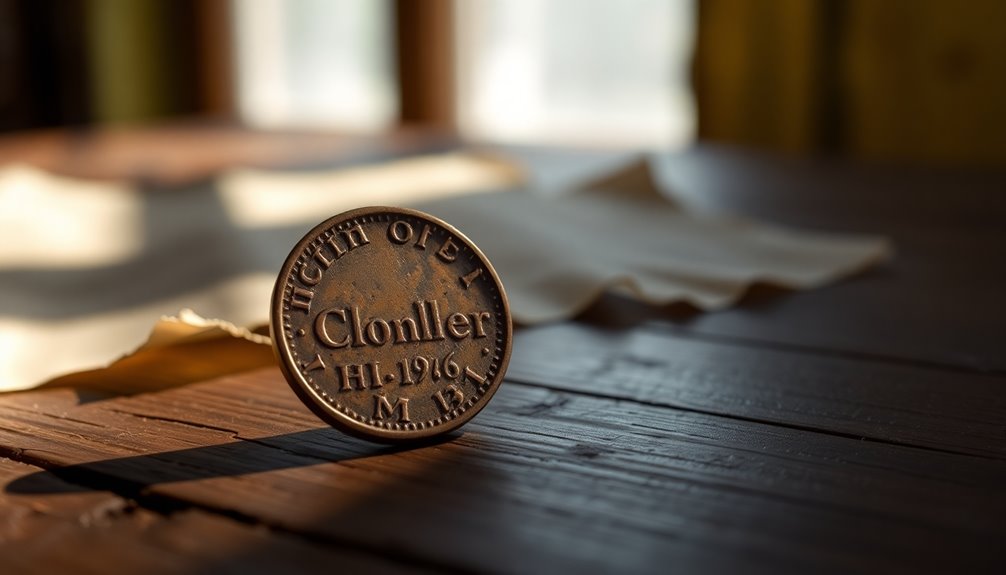The widow's mite teaches you that true generosity isn't about how much you give, but the spirit behind it. In the biblical accounts from Mark 12:41-44 and Luke 21:1-4, Jesus highlights a poor widow who contributed just two coins, yet he deemed her offering the greatest. This emphasizes that even small acts of sacrifice can carry immense value. While her story exemplifies profound faith and selflessness, it also critiques a system that exploits the vulnerable. If you're curious about the deeper meanings and implications of her act, there's much more to discover about generosity and its impact.
Key Takeaways
- The Widow's Mite refers to a biblical story where a widow donates two small coins, demonstrating the value of sacrificial giving.
- Jesus praises her offering over larger donations, emphasizing that true generosity arises from heart and commitment, not just monetary amount.
- The narrative critiques a religious system that exploits the vulnerable, highlighting the importance of addressing societal injustices in acts of giving.
- Sacrificial giving fosters community and spiritual commitment, showcasing that even small contributions can have immense spiritual value when given sincerely.
- The story encourages a spirit of cheerful giving, urging individuals to align their financial contributions with compassion and support for those in need.
Introduction
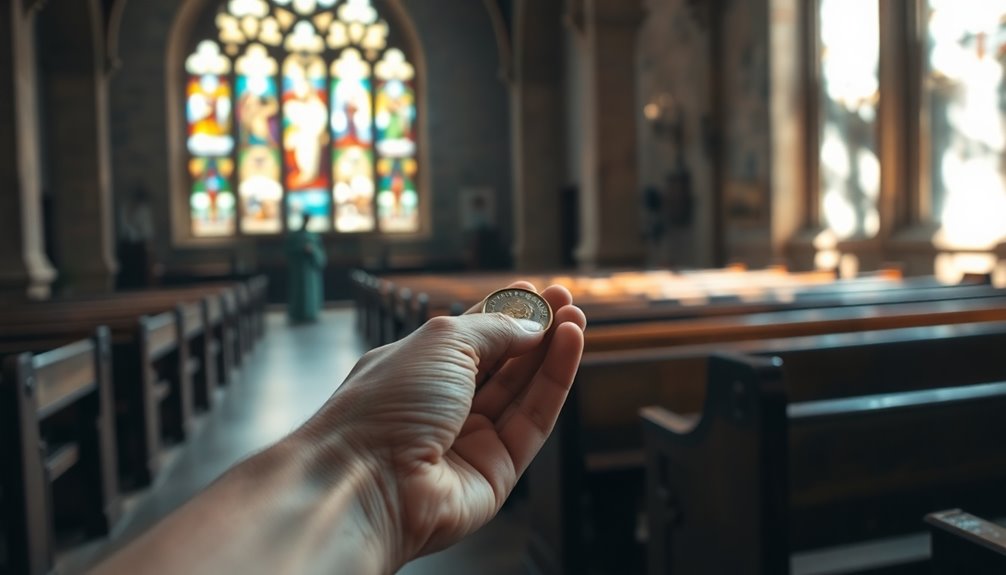
The widow's mite stands as a poignant testament to the power of sacrificial giving. When you hear the story of the widow who offered two small coins, you realize that true generosity often comes from a place of deep commitment rather than abundance.
In the Gospels of Mark and Luke, Jesus draws attention to her humble offering, contrasting it with the lavish contributions of the wealthy. While they gave from their surplus, she gave everything she had, showcasing a profound act of faith and love.
This narrative invites you to reflect on your own approach to giving. It's easy to think that larger donations are more valuable, but the widow's mite teaches you that the spirit behind the gift holds far more significance.
Sacrificial giving isn't about the amount; it's about the heart. Each time you give, consider the intention behind your gift. Are you giving cheerfully and selflessly, as urged in 2 Corinthians 9:7?
The widow's mite encourages you to evaluate your own sacrifices, reminding you that even the smallest contributions can have a monumental impact when offered with love and faith.
Biblical Context of Generosity

When you look at the story of the Widow's Mite, you'll see how it highlights the essence of generosity in biblical teachings.
Mark 12:41-44 and Luke 21:1-4 showcase the stark contrast between the wealthy's contributions and the widow's small, yet profound, offering.
This narrative not only reflects God's perspective on giving but also connects to broader biblical principles found in verses like 2 Corinthians 9:7.
Primary Bible References
While exploring the biblical context of generosity, you'll find that the story of the widow's mite stands out in Mark 12:41-44 and Luke 21:1-4. In these passages, Jesus observes people making donations to the Temple treasury, noting the large sums given by the wealthy.
However, it's the widow who captures His attention. She puts in two small coins—known as mites—that amount to practically nothing in terms of sterling silver. Yet, Jesus proclaims her contribution as the greatest of all.
This story illustrates a profound principle of sacrificial giving. The widow's act is significant not because of the monetary value, but due to the depth of her sacrifice. She gives all she's to live on, contrasting sharply with those who give from their abundance.
This narrative critiques the religious leaders of the time, who often exploited vulnerable individuals like her. Ultimately, the widow's mite embodies a larger biblical theme: the importance of heart and intention in our giving.
It serves as a reminder that true generosity springs from a place of need and selflessness rather than mere surplus.
Secondary Bible References
Understanding the broader biblical context of generosity enhances the lessons drawn from the widow's mite. This story, highlighted in Mark 12:41-44 and Luke 21:1-4, emphasizes sacrificial giving. The widow's two small coins, though seemingly insignificant, were valued by God for their heartfelt intention, showcasing that true generosity lies not in the amount given but in the spirit of the gift.
In 2 Corinthians 9:7, Paul echoes this sentiment, urging you to give cheerfully rather than reluctantly. This reinforces the idea that your heart matters more than your wealth. The widow's act stands in stark contrast to the wealthy donors, who contributed from their surplus. Her selfless giving highlights the biblical view of generosity as an act of love rather than obligation.
Moreover, Jesus' acknowledgment of her contribution critiques the religious leaders exploiting the vulnerable, like widows. This emphasizes social justice within biblical teachings.
The symbolism of the widow's mite extends to modern reminders, such as the Mite Bracelet, which serves as a tangible representation of humble gifts. You're encouraged to reflect on the profound significance of even the smallest offerings when given with sincerity and love.
First-Century Jewish Temple Practices
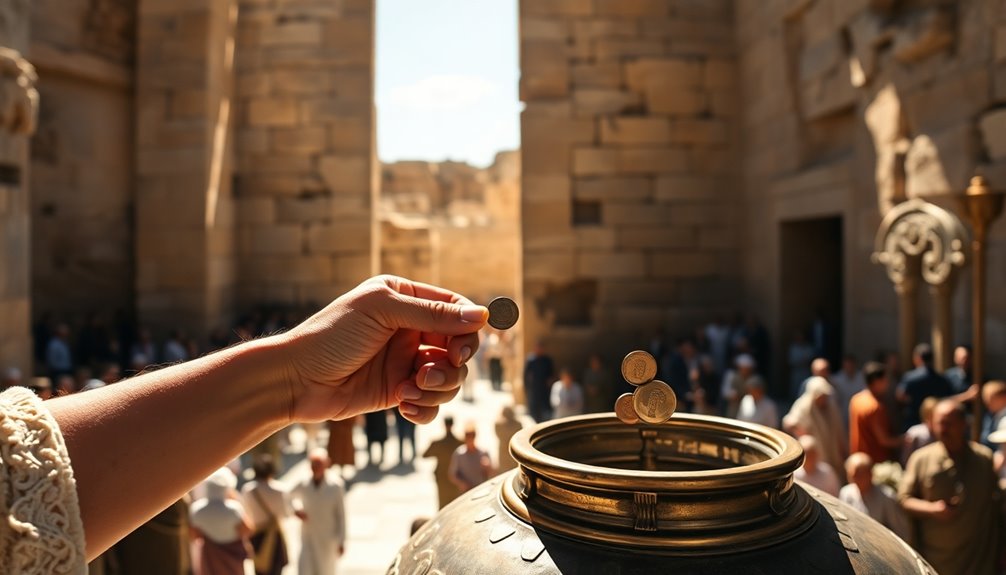
The First-Century Jewish Temple in Jerusalem was a vibrant hub of religious life, where worshippers gathered to make sacrificial offerings and monetary donations. This central place of worship was crucial for the community, as it supported the temple's operations and provided for the priesthood.
Inside, the treasury, known as the "corban," featured thirteen trumpet-shaped collection boxes, each designated for different types of offerings. Wealthy individuals often made large contributions, drawing attention and admiration, while poorer individuals, like the widow in the biblical narrative, contributed smaller amounts that often went unnoticed.
Tithing was a common practice, where you'd be expected to donate a tenth of your produce or income, showcasing your commitment to God and the community. In this environment, the act of giving wasn't just about the money; it reflected one's faithfulness and dependence on God.
The emphasis lay on the intention behind the gift rather than its monetary value, highlighting that every contribution, regardless of size, held significance in the eyes of God. Such practices fostered a sense of community and reinforced individuals' spiritual commitments, shaping the religious landscape of the time.
Cultural Significance of Sacrifice
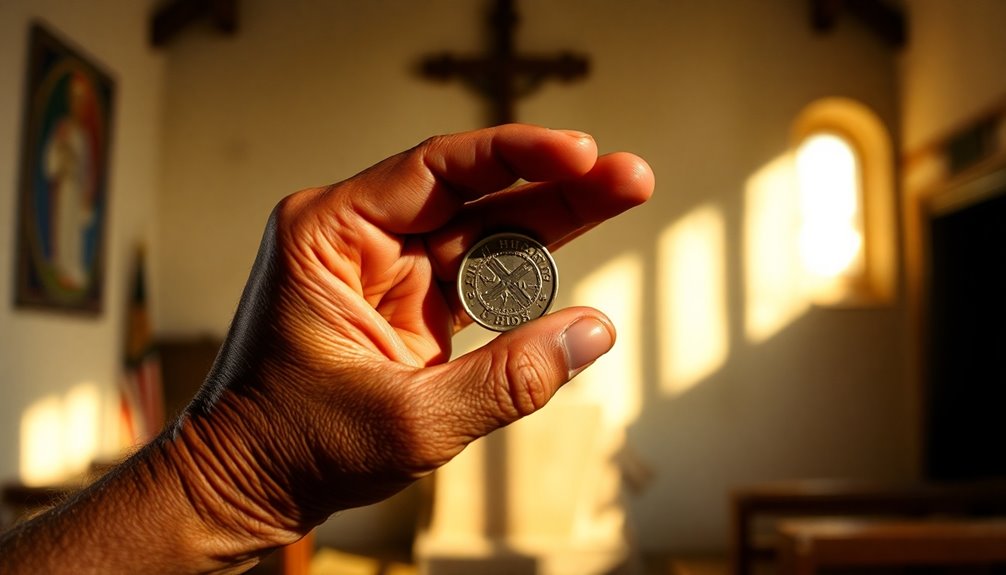
Sacrifice holds deep cultural significance, especially when viewed through the lens of the widow's mite. This powerful story illustrates that the true value of a gift lies not in how much you give, but in your willingness to sacrifice. While wealthy individuals contribute from their abundance, the widow's act of giving everything she'd underscores the moral importance of selflessness and generosity.
In many cultures, her contribution resonates as a call for compassion toward those in poverty. The narrative encourages you to reflect on your own giving practices, reminding you that even small acts of kindness can create significant change when motivated by sincerity. It emphasizes that true generosity often requires personal sacrifice instead of fulfilling an obligation.
The widow's mite has inspired various interpretations that highlight the need to support the less fortunate. It serves as a reminder that your intent and heart matter more than the monetary value of your contributions.
Misunderstanding the Widow's Intent
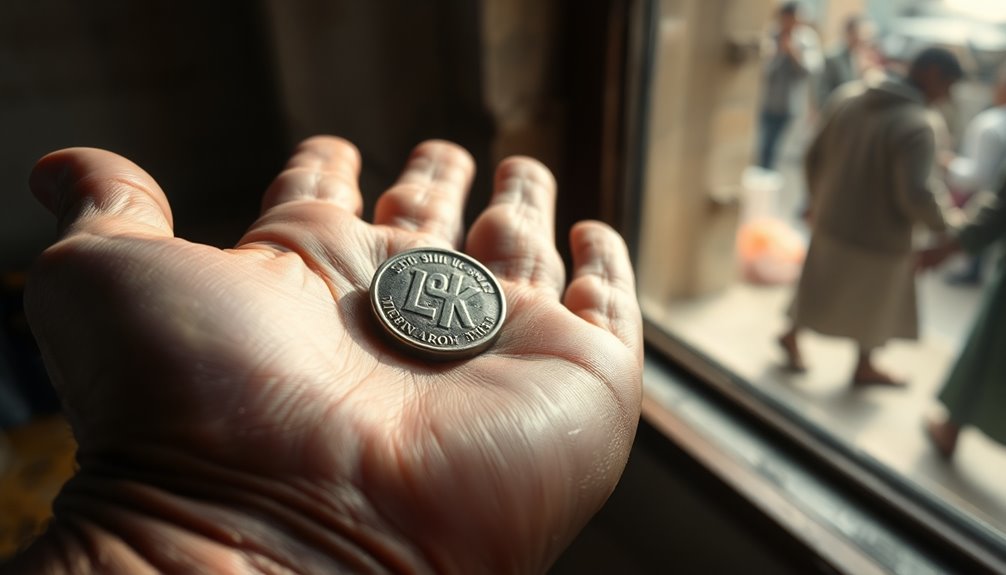
You might think the widow's contribution solely highlights her extraordinary generosity, but that's a common misconception.
Instead of glorifying sacrificial giving, her act can be seen as a critique of a system that exploits the vulnerable.
Debunk Common Misconceptions
Many people misinterpret the story of the widow's mite as merely a celebration of sacrificial giving. While her act of donating everything she'd is indeed powerful, it's crucial to recognize the broader context. Jesus didn't just highlight her contribution for its monetary value; He focused on her heart and intent. Unlike the wealthy who gave from their surplus, the widow's total sacrifice represented a deeper commitment.
Moreover, some interpretations suggest that Jesus' observation of her offering critiques the religious system that exploited vulnerable individuals, like widows. This narrative isn't solely about generosity; it challenges us to consider the inequalities present in society. The widow's mite symbolizes not only personal sacrifice but also underscores the need for social justice.
Additionally, reflecting on 2 Corinthians 9:7 reminds us that God loves a cheerful giver, emphasizing that it's about the spirit of giving rather than the amount.
Therefore, it's essential to move beyond viewing this story as a simple endorsement of giving and recognize its implications regarding the treatment of the marginalized. Understanding this nuance enriches your appreciation of the widow's story and its relevance today.
Critique of Sacrificial Giving
In examining the widow's mite, it's easy to fall into the trap of glorifying her sacrificial giving without fully grasping the implications of her situation. While her donation of two small coins symbolizes profound faith and trust, it also highlights a troubling reality. Critics argue that Jesus wasn't just praising her act; he was condemning a religious system that exploited her vulnerability. This wasn't merely about the widow's generosity but rather a critique of the scribes and leaders who took advantage of her and others like her.
Focusing solely on her sacrifice can overshadow the broader message of addressing systemic injustices that keep individuals in poverty. Instead of serving as a model for giving, the narrative warns us to consider the structures that limit true generosity.
It urges you to reflect on how societal inequities impact the ability to give, pushing you to reconsider what genuine generosity looks like in the context of social justice. Recognizing the widow's plight invites you to advocate for the welfare of the marginalized, ensuring that the true essence of compassion and support isn't lost amidst the romanticized notion of sacrificial giving.
Financial Stewardship Lessons

When it comes to financial stewardship, your individual priorities play a significant role in how you give.
Consider how your contributions can reflect your values and influence your community, as seen in the widow's example.
Additionally, think about how congregational giving practices can foster a spirit of generosity and support for those in need.
Individual Financial Priorities Matter
Why do individual financial priorities matter in the context of stewardship? The story of the widow's mite illustrates that it's not about how much you give, but the heart behind your giving. When you consider your financial priorities, think about how they reflect your values and commitment to support others.
The widow, giving her last two coins, exemplifies sacrificial giving, demonstrating that true generosity often emerges from those with limited resources. As you assess your own giving habits, recognize that even small contributions can hold immense spiritual value when offered sincerely.
It's vital to align your financial contributions with your desire to help those in need rather than focusing solely on accumulating wealth. This perspective encourages you to embrace cheerful giving, as noted in 2 Corinthians 9:7, where joy and purpose drive your financial decisions.
Ultimately, understanding your individual financial priorities helps you cultivate a spirit of generosity. When you prioritize supporting charitable causes, you not only enrich the lives of others but also deepen your own sense of purpose and fulfillment.
Your choices in stewardship matter, and they reflect your commitment to making a positive impact in the world.
Congregational Giving Practices
How can congregational giving practices transform both individual lives and the community as a whole? When you embrace sacrificial giving, like the widow in the biblical story, you realize that the value of your contribution lies in the heart behind it, not just the monetary amount.
Congregational giving encourages you to contribute according to your means, fostering a culture of generosity that uplifts both individuals and the community.
Many congregations teach the principle of tithing, urging you to give a portion of your income—often 10%—to support church operations and outreach initiatives. This not only strengthens your financial commitment but also enhances your sense of belonging.
Transparent financial practices in churches build trust, showing you exactly how your contributions are utilized. This transparency can inspire you to give more.
Additionally, educational programs on financial stewardship help you manage your finances better, covering budgeting, debt management, and biblical foundations of giving.
By participating in these practices, you not only support your church but also promote your own financial health.
Ultimately, congregational giving practices create a positive ripple effect, transforming lives and nurturing a thriving community.
Generosity Transcends Material Wealth

Embracing the spirit of generosity often reveals that true wealth lies not in the size of one's contributions but in the heart behind them. The biblical story of the widow's mite illustrates this perfectly. When the widow gave her two small coins, she offered more than just a monetary gift; she provided her entire livelihood.
Jesus highlighted that her sacrificial act surpassed the donations of the wealthy, who gave from their surplus, lacking true sacrifice. This powerful narrative aligns with 2 Corinthians 9:7, which reminds us that God loves a cheerful giver.
It's not about how much you give but the intention and sincerity behind your gift. The widow's mite has become a symbol of selfless generosity, teaching you that even the smallest contributions can create a significant impact when given with heartfelt intent.
Moreover, the story critiques societal structures that often exploit the vulnerable, urging you to focus on compassionate giving and social justice. As you embrace this mindset, you'll discover that generosity transcends material wealth, enriching both your life and the lives of others in ways that money alone can't achieve. Additionally, consider how financial needs can influence acts of giving, reminding us that generosity is a shared human experience.
Additional Resources

To deepen your understanding of the widow's mite and its significance, a variety of resources are available. Start with the biblical texts in the Gospels of Mark and Luke, where Jesus highlights the value of sacrificial giving through the widow's contribution. These passages provide context for the socio-economic critiques present in the narrative, particularly regarding the exploitation of vulnerable individuals.
For historical insights, consider books on ancient Judea's economy, which can shed light on the significance of the lepton as the smallest coin. Additionally, documentaries and lectures on biblical archaeology often discuss the widow's mite, offering visual context and expert interpretations.
If you're interested in collecting, look for authenticated widow's mite coins, which are valuable artifacts. Organizations like the Numismatic Guaranty Corporation (NGC) certify these coins, ensuring their authenticity.
You can also explore online forums and collector communities that discuss the history and significance of these coins.
Lastly, academic articles on the themes of generosity and socio-economic disparities in biblical texts can further enrich your understanding of the widow's mite and its broader implications.
Frequently Asked Questions
What Is the Meaning of My Widow's Mite?
Your widow's mite represents a small but significant contribution you make, often reflecting personal sacrifice or sincerity.
It's about what you give, not how much. When you give from your heart, even a little can have a profound impact.
It's a reminder that every effort counts, especially when it comes from a place of genuine care or need.
Embrace the idea that true generosity isn't measured by quantity, but by intention.
How Much Is the Widow's Mite Worth Today?
Today, the value of small, rare coins can vary widely based on their condition and authenticity.
If you're looking at coins similar to the widow's mite, you might find them ranging from $300 to over $700.
Collectors often seek out certified pieces, as they hold historical significance.
You should also consider that the rarity and condition play significant roles in determining the final price you might pay or receive.
What Is the Moral of the Widow's Mite?
The moral emphasizes that true generosity isn't about the amount you give but the heart behind it.
It challenges you to consider your intentions when contributing. Are you giving out of abundance or sacrifice?
It highlights the importance of selflessness, urging you to reflect on how your gifts impact others.
Ultimately, it reminds you that God values cheerful, sincere giving over mere financial contributions, encouraging you to prioritize the needs of those less fortunate.
Where Are Widows Mites Found?
You'll find Widows Mites primarily in archaeological sites across Israel, particularly around Jerusalem.
Excavations at historical places like the Temple Mount often reveal these ancient coins. They're remnants from the Hasmonean dynasty, dating back to around 103 to 76 BCE.
If you're interested in collecting, many reputable dealers offer these coins for sale, complete with authenticity certifications, ensuring you're acquiring genuine artifacts from that fascinating period in history.

